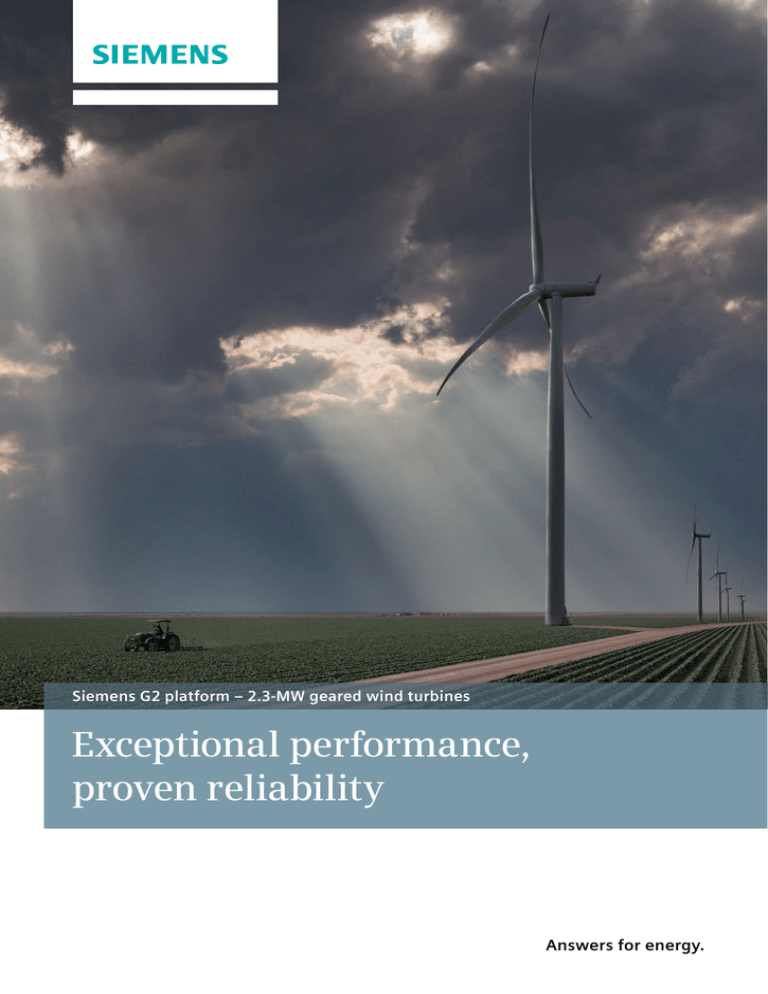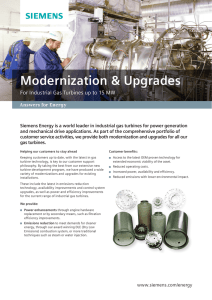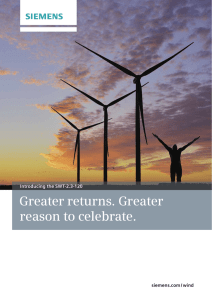
Siemens G2 platform – 2.3-MW geared wind turbines
Exceptional performance,
proven reliability
Answers for energy.
As the major driver
of innovation with more
than 30 years of experience, Siemens is the ideal
business partner.
Your trusted partner
Siemens has been a major driver of innovation in the wind
power industry since 1980 when wind turbine technology
was still in its infancy.
Technology has changed with the times, but Siemens’
commitment to providing its customers with proven wind
turbine solutions remains the same.
The combination of robust and reliable turbines, highly
efficient solutions for power transmission and distribution,
and a deep understanding of the entire energy market
ensures that Siemens will continue to take the wind power
industry to new levels.
Long-lasting customer relationships – based on a track
record of successful, reliable project deliveries – provide
for a sound, sustainable, and profitable investment.
2
Drawing on more than 30 years of experience in the
wind power industry, a strong focus on renewables, and
a global network of highly skilled and trained employees,
Siemens has proven itself to be a trustworthy and reliable
business partner and will continue to do so in the future.
With an increasing number of turbines being installed at
inland, coastal, and offshore sites, reliability and the best
maintenance in its class under challenging conditions are
essential for optimizing the return on investment
throughout a project’s lifecycle.
Over the past 30 years, Siemens has accumulated millions
of hours of service experience. Drawing on this substantial
knowledge, the company has established a flexible range
of service solutions that are designed to optimize the
output of wind turbines.
SWT-2.3-101
SWT-2.3-108
Intelligent ways to drive
down the cost of electricity
Wind power is coming of age. It could soon be directly
competitive with traditional energy sources. Driving
down the levelized cost of wind energy is a key target for
Siemens as we strive to make wind power independent
of subsidies.
Setting the standard for onshore availability
Innovation and industrialization are the main drivers of
this. And our new platform strategy, founded on the
knowledge and experience of more than 30 years in
wind power, is a milestone along this path.
The wind turbines of the Siemens G2 platform have
firmly established themselves as the proven workhorse
with rotor diameters optimized for all wind conditions.
Standardization and modularization are fundamental to
the new platform approach because they allow us to
streamline the entire manufacturing and installation process.
The organization of our product platforms into categories
allows standardized modules – such as rotors, generators,
towers, and hubs – to be used across different products.
The total number of different components is thus kept to
a minimum.
Each of our products is now a member of one of four
platforms: the Siemens G2, Siemens D3, Siemens G4,
and Siemens D6. “G” denotes geared turbines, “D” signifies direct drive technology, and the associated numbers
represent the predominant power rating.
Therefore, the G2 platform comprises onshore geared
wind turbines with a power rating of 2.3-MW.
The Siemens 2.3-MW turbines of the G2 platform represent the culmination of an evolutionary process of innovation and refinement to our wind turbines that dates
back to 1980.
Major components, such as the rotor hub, the main
shaft, the gearbox, and the yaw system, are of particularly sturdy dimensions, and all details are designed
using the highest engineering standards.
The rugged structural design, combined with an automatic lubrication system, internal climate control, and a
generator system without slip rings, contributes to exceptional reliability.
Innovative design and intelligent maintenance also
allows for reduced unscheduled servicing, which leads to
high yield with low operational costs and optimized
return on investment.
For superior availability, reliability, and a lower levelized
cost of energy, look no further than the Siemens G2
platform.
3
Expertise in practice:
fully developed technology,
advanced design
An extremely reliable product platform
Siemens wind turbines are designed to last. The robust
design of the G2 platform allows for reliable output
throughout the lifecycle of its wind turbines. The unique
blades are not glued together from a number of spars
and shells; they are cast in a single process using patented
IntegralBlade® technology.
4
This enables both low weight and incredible strength, as
there are no glue joints that could potentially expose the
blades to cracking and lightning damage. Climate control
within the nacelle protects vital equipment from the outside environment. In addition, controlled-wear strategies
for critical components result in a further reduction of
maintenance costs. Currently, the Siemens G2 platform
sets the industry standard for availability.
Superior performance
provides higher yields
Optimum energy output in moderate wind conditions
The Siemens G2 platform is designed to increase the
energy returns from sites with moderate wind conditions.
The advanced blade design with pitch regulation optimizes
power output and increases control over energy output.
High yield with low operating costs
Siemens optimizes the return on investment in its wind
turbines through intelligent maintenance that allows high
yield with low operational costs.
Advanced operation support
Given the logistical challenges associated with servicing
wind power plants, Siemens wind turbines are equipped
with a turbine condition monitoring system that reduces
the need for on-site servicing.
The condition monitoring system continuously checks
the external and internal condition of the wind turbine.
Continuous monitoring allows for the discovery of anomalies in time for routine maintenance.
Twenty-four hours a day, seven days a week, precise
measurements are taken of vibrations in the gearbox,
the generator, and the main shaft bearings. The system
instantly detects deviations from normal operating
conditions.
Using the knowledge gained from monitoring thousands
of wind turbines over the years, Siemens’ engineers are
highly skilled at analyzing and predicting issues within a
wind turbine.
This allows Siemens to proactively plan service and maintenance, as each service event can be categorized and
prioritized. Siemens can then determine the most appropriate course of action to keep the wind turbine running
at its best.
5
Proven technology,
advanced performance
Grid performance with the Siemens NetConverter®
Turbine Load Control (TLC)
Siemens sets the standard in the field of grid compliance.
Power conversion is implemented by Siemens’
NetConverter® system. This system iss characterized by
full conversion of the power generated, efficiently decoupling generator and turbine dynamics from the grid.
The Turbine Load Control system continuously monitors
the structural loading on the wind turbine. In case the
loads exceed normal values, the turbine automatically
regulates operation to bring loads back within the design
envelope.
The NetConverter® system offers maximum flexibility in
the turbine’s response to voltage and frequency control,
fault ride-through, and output adjustment. As a result,
Siemens wind turbines can be configured to comply with
a variety of relevant grid codes globally and can be readily
connected to the grid.
Siemens IntegralBlade® technology
The rotors of the G2 platform use Siemens’ unique blades
manufactured using patented IntegralBlade® technology.
The blades are made in one piece from fiberglass-reinforced
epoxy resin during a single production step. As a result,
all glue joints – the potential weak points that could
expose the structure to cracking, water ingress, ice forma­
tion, and lightning damage – are eliminated.
Siemens WebWPS SCADA system
Via a standard Web browser, the Siemens WebWPS
SCADA system provides a variety of status views of electrical, mechanical, meteorological, and grid station data
as well as operation and fault status.
High Wind Ride-Through (HWRT)
Wind turbines are normally programmed to shut down if
the 10-minute mean wind speed exceeds 25 m/s. This
may lead to significant challenges for the grid system if
the turbines in large wind farms are shut down more or
less simultaneously.
The Siemens G2 platform works to enhance grid stability
thanks to High Wind Ride-Through – an optional feature
of the G2 platform. This replaces the fixed high-wind
shutdown threshold with an intelligent load-based reduction in output power at some storm-level wind speeds.
Service
From the highly qualified local technician to the senior
engineer at service headquarters, it is the Siemens service
team’s track record and the vast amount of experience
gained over time that makes the difference.
Siemens offers tailor-made service solutions for each of
our turbine platforms, e.g. the SWPS-100B, the SWPS-200A,
and the SWPS-300W service solutions for onshore wind
turbines.
Wind turbine condition monitoring
Siemens’ turbine condition monitoring system compares
the vibration levels of the main nacelle components with
a set of established reference spectra and instantly
detects deviations from normal operating conditions.
This allows Siemens to proactively plan the service and
maintenance of the wind turbines, as any unusual event
can be categorized and prioritized based on severity.
6
Further improvements in safety
Safety is at the heart of all Siemens operations. From
production to installation, operation, and service, Siemens
strives to set the standard for a zero-harm culture.
Swept area:
8,000 m2
Swept area:
9,150 m2
Rotor diameter: 101 m
Rotor diameter: 108 m
SWT-2.3-101
SWT-2.3-108
IEC Class
IIB
IEC Class
IIB
Rotor diameter
101 m
Rotor diameter
108 m
Blade length
49 m
Blade length
53 m
Swept area
8,000 m
Swept area
9,150 m2
Hub height
Site specific
Hub height
Site specific
Power regulation
Pitch regulated
Power regulation
Pitch regulated
Annual output at 8.5 m/s
10,651 MWh
Annual output at 8.5 m/s
11,169 MWh
Nacelle weight
82 tons
Nacelle weight
82 tons
Rotor weight
60 tons
Rotor weight
60 tons
2
Optimized energy output in moderate wind conditions
Extra energy output in low to moderate wind conditions
The 101-meter rotor is specifically designed to optimize
the energy output in areas with moderate wind conditions.
The B49 blade’s pitch regulation optimizes and increases
control over energy output. Advanced blade technology
also allows for quieter operation, resulting in fewer
disturbances to both people and wildlife.
The SWT-2.3-108 offers a superior combination of a large
rotor and robust design. The B53 quantum blade of the
108-meter rotor uses Siemens’ innovative aeroelastic
blade design, which allows a larger rotor diameter and
higher energy output without increasing structural loads.
As a result, the SWT-2.3-108 turbine provides a lower
cost of energy in low to moderate wind conditions.
With thousands of units installed both on- and offshore, 2.3-MW turbines are unrivaled in their class when it comes to
performance, productivity, and availability.
7
Published by and copyright © 2014:
Siemens AG
Energy Sector
Freyeslebenstrasse 1
91058 Erlangen, Germany
Siemens AG
Wind Power
Lindenplatz 2
20099 Hamburg, Germany
siemens.com/wind
For more information, please contact
our Customer Support Center.
Phone: +49 180 524 70 00
Fax: +49 180 524 24 71
(Charges depending on provider)
E-mail: support.energy@siemens.com
Wind Power
Order No. E50001-E310-A201-X-7600
RS 15_01_110
Printed on elementary chlorine-free bleached paper.
Subject to change without prior notice.
All rights reserved.
The information in this document contains general
descriptions of the technical options available, which may
not apply in all cases. The required technical options
should therefore be specified in the contract.
Trademarks mentioned in this document are the property
of Siemens AG, its affiliates, or their respective owners.





